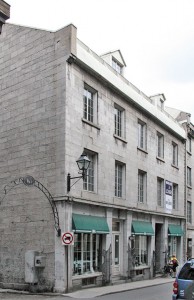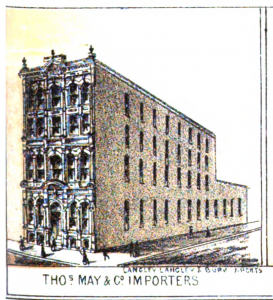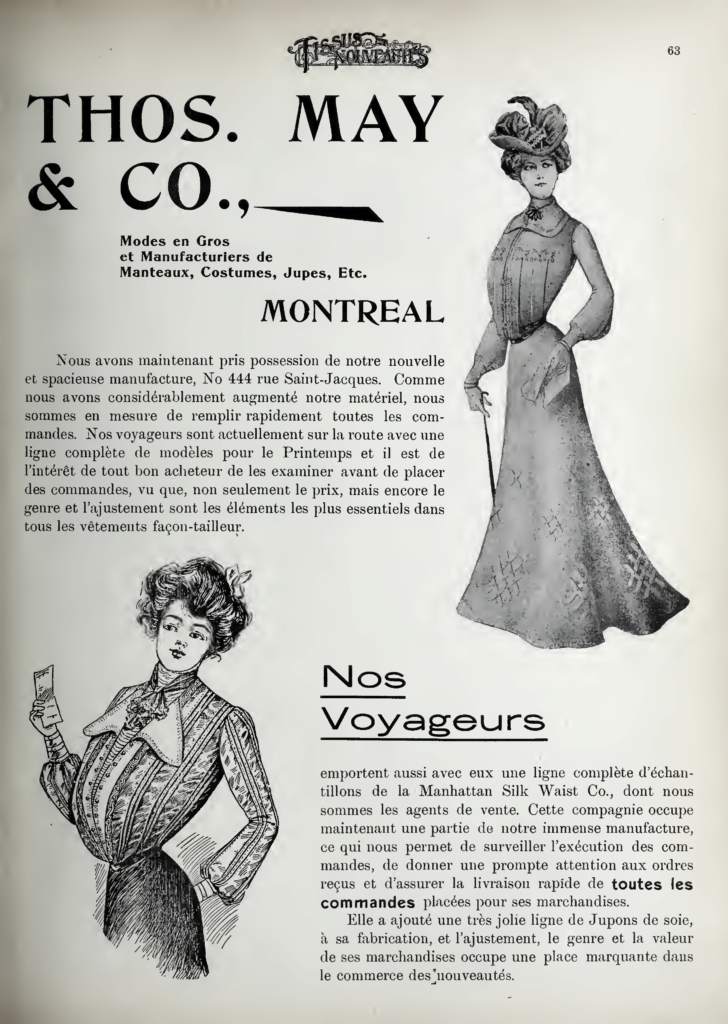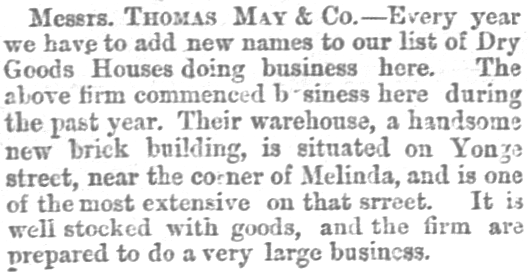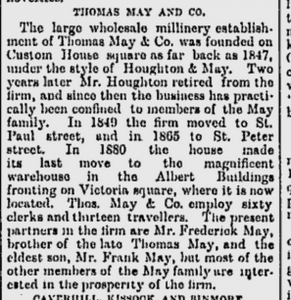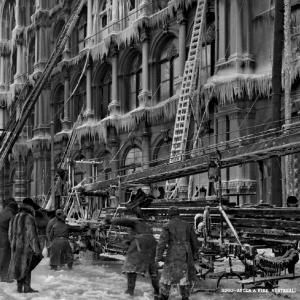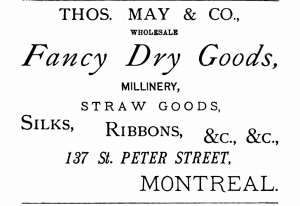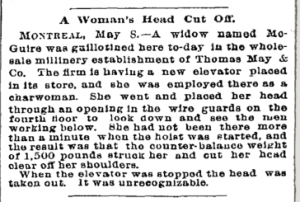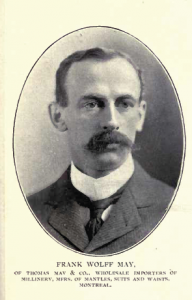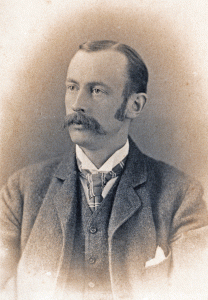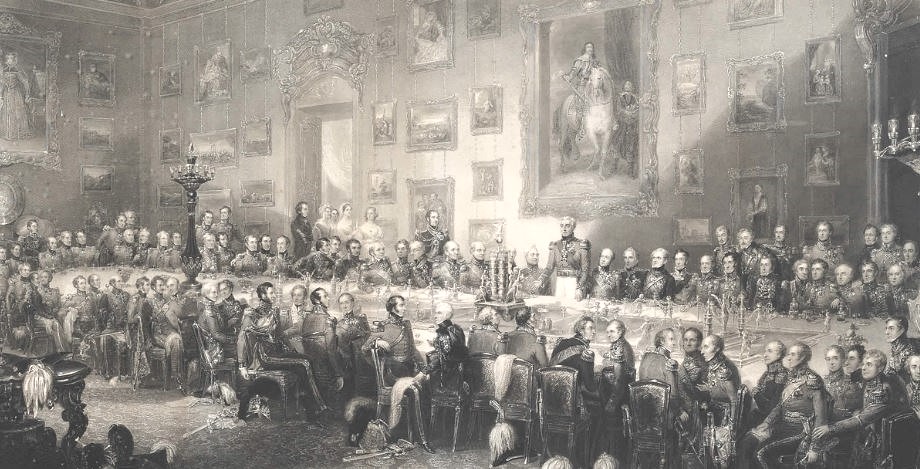The May family unites with the Man family through the marriage of Harry Morgan Stoe Man to Nora Loeck in 1909. Nora’s mother was Eleanor Ida (May) Loeck the daughter of Thomas May and Ida Marie Wolff.
Thomas was the son of John May (left). John (1775–1855) married twice, first to Charlotte whose last name is not known and second to Phillis Eliza Baker.
With his first wife Charlotte, John had at least four sons: , Alfred John (1824 – 1855), Thomas, Edmund George, and Charles and a daughter Eliza Amelia.
With his second wife Eliza, John had several children including Frederick Albert May who married Ida Wolff’s sister Clara, as well as several daughters – Augusta Maria, Janette Elizabeth, Emma, and Louisa Ann, (based on the 1841 census).
Thomas May married Ida Wolff in Hamburg before 1855 and they had seven children:
- ALICE FANNY born 1855 in Montreal, Canada. She married Maximilian Emil Wolff;
- FRANK WOLFF born 1856 in Hamburg, Germany. (see notes below)
- GUSTAVE CHARLES born 1858 in Montreal, Canada. He married Aimee Charlotte Gault. They had one son – Robert – but no descendants.
- FLORENCE ELIZA born on 12 May 1859 in Montreal, Canada (She married Walter Pocock, M.D. Details of this family can be found here (<– PDF)). No descendants.
- ELEANOR IDA CLARA who married Otto Loeck
- EVELYN (Effie). She married Louis Gustave Schwabe. No descendants.
- SYDNEY / SIDNEY
Below, five of the seven May children:
Below, Harvestchuder Weg 10, Hamburg, the home of the May family which was subsequently demolished and where now stands the music department of the University of Hamburg.
Below, Thomas May from a photograph in the family’s possession. At the McCord Museum in Montreal, Canada, there is a collection of studio portrait photographs of various members of the May and Wolff families. A PDF has been created of these photographs which can be viewed HERE.


From the 1861 Canadian census we can gather the following pieces of information: Thomas May was born in England and is listed as aged 32 in 1861 which means he was born in 1822. Another source says that he was born on 6 Jun 1819 in Kent. His wife Ida Marie Wolff (daughter of Moritz Wolff and Fanny Maria Schwabe) is shown as 27 years old in 1861 which means she was born in 1834 in Hamburg, Germany.
Also listed on the census is Eliza May, aged 32, whom we assume is Thomas’s sister and Frederick, aged 22, who is Thomas’s half-brother. Otto Wolff, Ida’s 21 year old brother, is also a resident. The children listed are: Alice, Frank, Gustave, and Florence. The family is living . They are residing in a two story brick house on a quarter of an acre of land with three servants. They are located outside the city limits at 68 Dorchester St West. This is confirmed by Lovell’s Montreal Street Directory for 1860-61, that also has Thomas May listed at that address. Lowell’s describes Dorchester West as running from Mountain Street westwards to beyond the city limits. (Dorchester is now known as Boulevard Réné Levesque, and is still named Dorchester in Westmount).They own a cow valued at $200 and a carriage for their personal use valued at $100.
Also found a christening record entry for Gustave at St George’s church Montreal.
1. Gustave son of Thomas May & of Ida Marie Wolff his wife was born on the Fifteenth [?] day of February Eighteen Hundred and Fifty Eight [1885] was Baptized on the Twenty Third Day of March [?] of the same Year.
[Signed] By [?]
Parents names:
Thomas May
Ida Fanny [?] May
Sponsors: (There are some names that cannot be distinguished – ‘Charles May’ by Proxy Thomas May’ [?]
Below, a fan in the possession of the family, showing the seven May children:

Below, Thomas and Ida (Wolff) May’s grave at Hamburg.
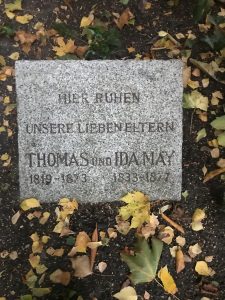
THE FAMILY OF FRANK WOLF AND ELIZABETH MARY (VANKOUGHNET) MAY
Frank Wolff May was the eldest son of Thomas and Ida (Wolff) May. He was born on 8th September 1856 in Hamburg, Germany and he married Mary Elizabeth Van Koughnet (b. 1861) on 30th July 1884 at Halton, Ontario, Canada.
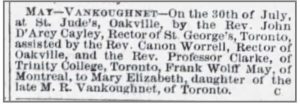
They had three daughters. Frank died on 22 November 1934 and was buried at Cimetière Mont-Royal. Mary died on 1st January 1953 and was also buried at Cimetière Mont-Royal.
The eldest daughter, Lilian Gretchen, was born on 23 June 1885. On 23rd October 1906 she married John James Alexander Riddell at Montreal. Lilian Gretchen (May) Riddell died on 10 November 1935 and was buried at Cimetière Mont-Royal.
Below are the baptismal records for two of Frank and Mary Elizabeth (VanKoughnet) May ‘s daughters: Beatrix (sometimes Beatrice) Gladys May who was born on 5th October 1886 and Elsa / Elsie Marjorie May who was born on 11th April 1890. Both were baptized at St John the Evangelist Anglican church in Montreal Canada.
Elsa Marjorie died, unmarried, on 13th October 1968 and was buried at Cimetière Mont-Royal. Elsa followed a career in painting portraits but we have been unable to trace many of her paintings. A summary of her life in PDF can be read HERE.
In 1906, at Richmond, Surrey, Beatrice Gladys May married Allan Dickson Grigg (1872-1955) of Eastcliffe Lodge, Bembridge on the Isle of Wight; where they kept and bred a herd of Jersey cattle. Allan Grigg was a close friend of the British Prime Minister David Lloyd-George (1863-1945). He and Beatrice’s home still stands today, enjoying “an exceptional position over-looking the eastern approach to the Solent” on the mainland. The house was re-built by them after an extensive fire in 1930 and has ten bedrooms and extensive grounds which includes its own sandy beach. The house was rented by the Griggs from Lady Alice Fitzwilliam.
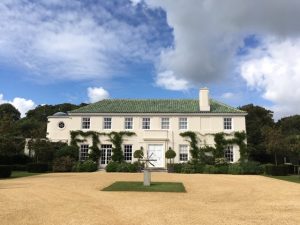
Beatrice’s husband was the son of Henry Tully Grigg (1839-1887) Esq., of Queensberry House, Richmond and Buenos Aires, Argentina, by his wife Mary Emma Dowse. The Griggs had an extensive cattle business in Argentina (where Allan was born and died) and after his father’s death, Allan continued to run the firm. Allan’s sister, Elsie Vaughan Grigg (d.1942), married Sir Ralph St. George Claude Gore (1871-1961) 10th Bt., President of the Royal Yachting Squadron. Allan’s brother, Major Ralph Stuart Grigg of the 18th Hussars (though he lived at Buenos Aires too), married his brother-in-law’s sister, Hilda Gore, and they were the parents of Joan Stuart Grigg who married Sir Terence Hume Langrishe (1895-1973) 6th Bt., of Knocktopher Abbey, Co. Kilkenny. [The above two paragraphs borrowed from Mark M. Thank you Mark.]
The children of BEATRICE MAY and ALLAN GRIGG are:
i. CASINIER MICHAEL;
ii. PETER FRANCIS (Born on 30th January 1910. Baptised on 6th March 1910 at St Saviour, Upper Chelsea and died in the last quarter of 1910);
iii. MALCOLM ALLAN TULLY b.1908 d.1931; and
iv. ELIZABETH BEATRIX, b. 1912; m. 1948 at Ely, Cambridgeshire, TADEK KUPHAL; b. 1896.(Tadeusz Kuphal / Tadeusz Ruhpal).

Below the death announcement for Beatrice (May) Grigg

THOMAS MAY’S COMMERCIAL HISTORY
Thomas started out in partnership with a Mr. Houghton. The following is from a Montreal Business Directory dated 1851:
HOUGHTON & MAY, importers of foreign and British staple and fancy dry goods, German plate, window and fancy glass, Berlin wools, embroideries, &c., 182 St. Paul st.
Left one of the earliest locations of Thomas’s warehouse located at 180-194, rue Saint-Paul Ouest in Montreal. Thomas held the lease on the building in 1864.
The following is taken from Illustrated Toronto: Past and Present by J. Timperlake.
Thomas May & Co.—The warehouse of this firm is one of the handsomest and most commodious in the city, and is situate on Wellington street west, between Bay and York streets. The building is in the Louis XIV. style of architecture, designed by Langley, Langley & Burke, 180 feet deep, by 40 feet frontage, and is five storeys high. The front is highly ornamented, being of finely cut stone, the massive colurans, imposing doorway, and beautifully carved centrepiece giving it an imposing beauty not equalled by any other importing house in the city. The house is . a branch of the Montreal firm of T. May and Co., the largest importers of millinery, fancy dry goods, mens’ and boys’ felt hats, &c. This house has been established over twenty-five years. The firm consists of Messrs. J. Richard Wolff, T. A. May, and James Paterson, Mr. Paterson being the resident partner of the firm.
The Globe, Toronto, Ontario, 12 January 1869
The city of Montreal, Que., was unfortunate in January in being visited with a series of disastrous fires. On the night of the 18th the premises of Thomas May & Company, corner of McGill and St. James streets, were gutted, with a loss of about $350,000.
Below from Canadian Electrical News, Volume 11
A couple of items in the daily press lately are worthy of note … another daily voicing its views on the late destructive fire at Thos. May [it Company’s, says : “It will probably never be known what caused the fire, but no doubt it was due to electric wires.” (When in doubt, blame electricity.)
It is possible, but highly improbable, that the late fire in Thos. May & Company’s was electrical. The fire, it is admitted, started about to p.m. Now, the establishment in question closed at 6 p.m., and it is rather unlikely that it should smother until then, especially as the factory portion of the establishment has considerable wooden benching, partitions, etc. Again, if the office clerks were back after hours they would have used gas, as the electric light installation was not extended to the. ground floor. So far as the motor circuit is concerned (50 V. D.C.), the wires entered by a window, on the top floor and the interior circuit ran only about 2 feet to where the motor was located, same being duly provided with a D.P.].K. switch. The electric lighting outfit was limited in its area, and was “open cleat” style, and not of an ancient type. The chances are far stronger that the fire can be laid down about the sewing machines (run from shaft) under bench, as actually was the case in the former Bernier & West fire ; the daily news putting it to electricity, notwithstanding proof.
Below from The Postal Record, 1892:
A clever swindler has been extensively using the mails in this way: He would notify dry goods and millinery dealers that a large Canadian firm “May Thomas & Co.” had sent them very valuable samples. Later in some adroit manner he secured duplicates of custom house stationery and sent notices to the effect that valuable goods for “you” were detained for payment of custom duties amounting to $5.00. Many were victimized and the good name of the firm of Thomas May & Co. of Montreal suffered. The swindler has been caught.
Below from STYLE Magazine of 1893.
AN INGENIOUS SWINDLE.
An ingenious swindler, giving his name as O. E. Small, has just been arrested in Detroit. His method was simple yet most effective. He sent out circulars to the millinery trade of the United States purporting to be from May, Thomas & Co., of Montreal, announcing that the firm had forwarded to them a sample case of goods. He next sent them a card purporting to come from the Detroit custom house announcing the arrival of the goods and asking them to remit $3.50 for customs charges to Lock box 162, Detroit. The scheme worked like a charm.
Most of his dupes believed the firm of May, Thomas & Co. was the same as Thomas May &: Co., the well-known millinery firm of Montreal, and had no hesitation in forwarding the money at once. As the goods did not turn up, they wrote to Thomas May & Co., asking for an explanation, and when that firm realized that a swindle was being worked under a colorable imitation of their name they promptly placed the matter in the hands of Detectives Grose and Carpenter, who soon ran their man to earth. Saturday’s mail brought seventy-five letters from people who had sent money to the swindlers asking for the goods from Thomas May & Co., and Detective Grose has now over two hundred letters from milliners who had duly forwarded the $2.50 asked for to Lock box 162.
PUBLIC Notice is hereby given that under The Companies Act, 1902, letters patent have been issued under the Seal of the Secretary of State of Canada, hearing date the 17th June, 1904, incorporating Edward J. Major, merchant, Bernard McNally, secretary, and Hercule Giroux, commercial traveller, all of the City of Montreal, in the Province of Quebec ; William Macculloch, banker, of the City of Toronto, in the Province of Ontario ; and Dame Mary Elizabeth Van Koughnet, wife separate as to property of Frank W. May, merchant, of the City of Montreal aforesaid, for the following purposes, viz :—
- To acquire the assets and assume the liabilities of the firm known as “ The Canada Ribbon Company,” and to carry on the business and trade now carried on by said firm.
- To carry on business, and trade generally as importers of fancy dry goods, ribbons and milliners’ goods and supplies of al kinds.
- To buy and sell, on wholesale and retail, and trade generally in all kinds of ribbons, fancy dry goods and articles of millinery.
The operations of the company to be carried on throughout the Dominion of Canada and elsewhere, by the name of “Thomas May and Company ” (limited), with a total capital stock of forty-eight thousand dollars, divided into four hundred and eighty shares of one hundred dollars, and the chief place of business of the said com any to be at the City of Montreal, in the Province of Quebec.
********************
Frank Wolff May died on 22 November 1934. He was cremated and his ashes placed at Mount Royal Cemetery, Montreal.
As with a large number of commercial enterprises Thomas May & Co found itself a plaintiff in the case of Houghton and May v Hudson which has been summarized HERE.
Thomas May’s Siblings: This section is ‘under construction’ and has very little data at this point. Thomas had at least two brothers: Charles and Edmund George. The former had quite a career in the Hong Kong police force.
1. EDMUND GEORGE MAY.
Edmund was born in 1820 and baptised on 5th August of that year at St George’s, Hanover Square.

According to The Times announcement (below) Edmund George married Jenny Baur on 21st May 1859:
However we also have a record of Edmund having married Sarah Jane Baxendale on 21st May 1859 at Saint James, Westminster. The marriage record shows that Sarah Jane’s father was James Baxendale – Gent deceased.
There is also a marriage record of James Baur and Hannah Baxendale (nee Walker) dated 4 Aug 1857 at Old Church,Saint Pancras. We assume Hannah is the mother of Sarah Jane and that James Baur in some sense adopted Sarah Jane.

Edmund and Sarah Jane (Jenny) had one son: Percy James May born 8 May 1860 at Regent Street, Middlesex. Edmund appears on the 1861 census in the household of his father in law James Baur and his mother in law Hannah Baur along with his son Percy living at No. 20 Blenheim Road, Marylebone. Jenny does not appear on the 1861 census.
Hannah (Walker) (Baxendale) Baur died sometime in the last quarter of 1861. James Baur went on to marry someone by the name of Charlotte as indicated on the 1871 census.

Edmund died on 6th August 1880. His death was registered by his half brother Frederick Albert May. Edmund’s probate record:
PERCY JAMES MAY
Percy was the son of the above Edmund George May. At the age of 27, Percy married Lizzie Dobby, the daughter of Phillip Dobby, on November 1st 1887 at St Paul’s, East Molesey, Surrey. They had one daughter, Winifred Clara May, who was born in 1890 and baptised on May 5th of that year. Percy died in 1903 and Lizzie in 1949. Winifred married John William Cabourn. They do not appear to have had any children.
THE BATTLE OF WATERLOO: Below is a picture of the celebration of the 1836 anniversary of the Battle of Waterloo. It is said that during the dinner, and as they were about to make the toast, the King (William IV) asked Wellington if all those who had participated in the battle and who were in Apsley House were present in the room to which Wellington said ‘yes’ but the king said ‘Not quite everybody’, and he told Wellington that he had spotted several Metropolitan Police men (including John May) who were wearing Waterloo veterans medals and he suggested to Wellington that he should invite them in. The painting shows one, a man in black standing in the doorway quite some way to the right of Wellington. He is the only one not in military uniform. The ‘uniform’ of the metropolitan police at the time was either very dark blue or black. Somewhere there might be a numbered key to this painting. The original hangs in Apsley House.
More on the painting: this is the William Salter painting of the 1836 Waterloo Banquet held in the Waterloo Gallery at Apsley House. Salter painted 81 individual portraits before incorporating them over a five year period into the painting. The Banquet was first held in 1820 at Apsley House on the anniversary of the Battle of Waterloo the 18th June. It was in fact an annual reunion of the major players on the allied side at the battle. In 1836, the 21st anniversary of the battle, the guest of honour was the Prince of Orange and The Duke of Wellington can be seen addressing his guests. Also at the 1836 banquet were several Superintendents of the Metropolitan Police, Superintendents May, Baker, Williamson, Grinsell, and several others were allowed into the Gallery to view the animated scene, I don’t think they were offered any food. The reason why these particular Superintendents were invited into the banquet was because they were Waterloo veterans.
In 1829 Robert Peel appointed Colonel Charles Rowan and Richard Mayne to become the first joint Commissioners of the Metropolitan Police, Rowan was a Waterloo veteran having been a Major in the 52nd Regiment (Oxfordshire Light Infantry) and second in Command of the Regiment at the battle, he later became Colonel of the Regiment after the war. Peel’s intention was for the Superintendents, who were in charge of Companies or which soon became Divisions, to be former military officers but both Commissioners rejected this proposal and insisted that the role be performed by former non commissioned officers of the army. They had to resist great pressure from the officer caste to implement their aim. When the Metropolitan Police began working the streets of London in September 1829 the majority of the Superintendents were former senior army NCOs. Superintendent May was the first Superintendent of the 1st Company or ‘A’ Division based at Great Scotland Yard, a name which soon became abbreviated to just Scotland Yard.






